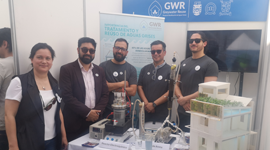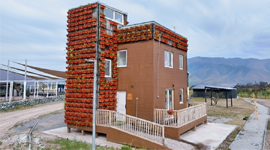You are here
Green walls, a contribution to housing sustainability.

The implementation of green walls in buildings is gradually becoming a real alternative to improve the sustainability and habitability of housing, as they act as thermal regulators, serve as an acoustic barrier to reduce noise, improve biodiversity, contribute to clean air by filtering CO2 and have an impact on emotional wellbeing, among other benefits.
The figures are promising: some studies show that green walls can reduce noise levels by about 10 decibels, lower temperatures by up to 5 degrees in summer and maintain it in winter. Also, each square meter of green wall can filter up to 2 kg of CO2 per year.
Different types
According to Ricardo Abejón, PhD in Chemistry and member of the GWR project, there are different types of green walls that, despite their different structure and implementation, have the same benefits: the direct and indirect ones. The first type corresponds to the model in which the plant species are planted in the soil and develop on elements placed on the wall to cover it, while in the second type the plants live and grow in container elements placed on a supporting structure.
Indirect green walls have the greatest potential for use in buildings and are often used in cities. Among the most commonly used there is the panel type, which consists of panels with plants mounted on a structure; the felt type, where the plants are placed in pockets of a large fabric of this material installed on a waterproof barrier; and the trellis type, where the plants are planted in pots attached to a frame installed on the wall.
Whatever the case may be, it is essential to make an appropriate choice of the species to be used, which should be chosen taking into account the climatic conditions of the place where they are to be placed, to ensure that they behave well in all seasons of the year and that, ideally, they are specimens that do not develop large roots. The choice of substrate is another determining factor, as is the availability of a suitable irrigation system. An automated option that relies on sensors to monitor moisture levels and ensure that watering is adequate in both frequency and quantity is ideal.
GWR Project
According to Dr. Esteban Quijada, director of the GWR project, the final stages of the pilot experience carried out under the GWR project are currently in the works to determine the plant species that perform well on green walls in the metropolitan area. The study was conducted over a three-month period, during which the plants were irrigated with three types of water: untreated graywater, graywater purified by electrochemical processes, and drinking water.
Preliminary results indicate that Cinta or Malamadre (Chlorophytum comosum), White Ivy (Hedera helix variegata), and Dymondia (Dymondia margaretae) have the characteristics to adequately tolerate the hot and cold conditions found in the Chilean capital.
The green walls are already being installed in the sustainable house built by the project at the Corfo Technology Center (CTEC), in the Carén Lagoon, and will be irrigated with gray water treated by an electrochemical and membrane system that eliminates traces of grease, detergents and dyes, among other residues that could affect the quality of the soil and the life of the plants.
Expoagua
At the Expoagua, to be held on October 10th at the Metropolitan Santiago Convention Center (formerly Casa Piedra), the GWR project will present a pilot project that will show how the greywater filtration system works, designed to reuse up to 70% of the 170 liters of drinking water that a person consumes on average every day.
News
 GWR project at the Environmental Fair
GWR project at the Environmental Fair
 GWR researcher participates in major science conference in Portugal
GWR researcher participates in major science conference in Portugal
 The GWR Project has achieved the technological integration of gray...
The GWR Project has achieved the technological integration of gray...

